Archived Article Detail
By Thomas P. Moore
Need to search for a keyword, title or article on this page? On your keyboard, hold down the “Ctrl” and “F” key and a “Find in page” box will appear at the bottom of your screen. Type in your keyword and check the “Highlight All” box and like magic your keyword will appear highlighted as you scroll up and down the page!
WHAT’S NEW IN THE MINERAL WORLD ARCHIVE – posted on 7/18/2005
Summer is generally a slow time in the mineral world, but below are some gleanings from the web and from the grapevine which, I hope, will help you get through it until the fall quickening of the Denver Show, or whatever similar action there is where you’re from.
What’s New
.jpg)
.jpg)
As seems to have become customary for these reports, we’ll begin with some mineral news from China.
My print report on the 2003 Tucson Show (vol. 34, no. 3) contained extended ravings about the new Chinese mimetite then just becoming known, and a 7.3-cm superstar specimen from the Tom Hall collection was pictured on that issue’s cover. There was initial confusion about the true locality, but by now we have learned that it is the Pingtouling mine near Liannan, Guangdong province. Ever since this debut of the mimetite I have been looking for information regarding what other species this mine might produce—for it would seem unlikely that mimetite, especially of this world-class caliber, is the only mineral found in significant specimens in the mine. Well, Martin Jensen can help with this question. For the past several years Martin has been making safaris to China for the Collector’s Edge dealership (he left the company recently), and a couple of months ago he returned with the news that in November 2003 a major pocket of scorodite was found in the Pingtouling lead mine. A whole ore car full of crystallized scorodite was removed, Martin says, but the significance of the material was only recognized at the last moment before the ore car left for the crusher, and only about 30 specimens were saved (and wouldn’t we like to hear the no-doubt thrilling details of this rescue story?). Martin brought the 30 scorodite specimens to the U.S., and John Veevaert picked up about eight of them, but, sorry, none presently are available on the market. As the pictures here show, the scorodite crystals, reaching 1 cm individually, are sharp, mirror-faced, lightly striated, and highly lustrous, and they show an outstanding color-change, from blue-green to purple-blue, when moved between indoor and outdoor lighting. The crystals line cavities in earthy brown gossan, with anglesite, arsenian siderite, and microcrystals of beudantite. Some of the large matrix pieces with dense crystal blankets make outstanding scorodite specimens…and so now we know what to look and hope for, besides mimetite, from the Pingtouling mine. There is no way to know, of course, whether this hope might someday be realized in a manner we can call generous.
From Tucson 2005 I mentioned very briefly the gorgeous pink fluorapatite specimens which seem to trickle out once every few years from the emerald mines of Colombia, and a thumbnail-size cluster of lustrous, stacked, tabular crystals was pictured with the report (vol. 36, no. 3, p. 291). It’s too bad that these specimens are (1) so rarely seen, (2) tend to be overshadowed, even when seen, by the emerald crystals from the same place, and (3) sometimes gets merged, in the mineral-shopper’s mind, with similar-looking pink fluorapatites from Pakistan. John Veevaert passes on the information—and John got it from one of the “emerald guys” from Colombia (usually so secretive)—that the fluorapatites come (or some of them come, anyway) from the La Marina mine, Pauna, Boyaca, Colombia. The fluorapatite is fluorescent bright pink under shortwave ultraviolet light, and in matrix specimens the pink crystals perch nicely on sparkly white, well crystallized albite and calcite.
Nice specimens displaying pale pink crystals of fluorapatite have also emerged recently from a small granite quarry about 1 kilometer from the village of Malpartida, near the historic town of Almeida, Guarda district, Beira province, northeastern Portugal, a mere 5 km from the border with Spain. These very pretty specimens are to be found on the website of Edelweiss Minerals (www.edelweissminerals.com), a business, fairly new to the web, run by Felix Garcia of Salamanca, Spain. Felix writes me that he collected good pegmatitic minerals, including the fluorapatite, in the Malpartida and a couple of nearby quarries in 2002 and 2003. He had gone to the place chasing rumors of large helvite crystals, but found in the quarries, instead, good specimens of smoky quartz (lustrous coffee-colored, transparent crystals to 8 cm) schorl, albite, muscovite and—your favorite—the gemmy, pale pink, very sharp and bright crystals of fluorapatite, perched well, as small clusters and isolated singles, on matrix composed of the other species just named. The crystals always show prism, pinacoid and several sets of bipyramid faces, and some are so complex as to look quite rounded; like their brothers from Colombia they are fluorescent, but (not surprisingly) they fade, with time and sunlight, to colorlessness. Individual crystals exceptionally reach 1.5 cm. 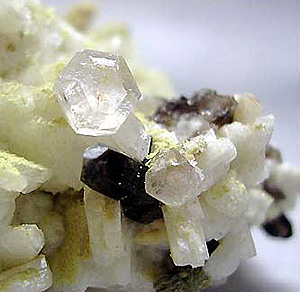
If you visit the Edelweiss Minerals site it will also surprise you with some very fine specimens of gem spodumene and gem scapolite from Alto Ligonha, Mozambique. In their thorough article on the famous Alto Ligonha pegmatite district (vol. 31, no. 6 of the Mineralogical Record), Manuel Bettencourt Dias and Wendell Wilson mention that these items do occur at Alto Ligonha—and they illustrate a yellow-orange, terminated gem scapolite crystal, 2.8 cm long, much like those shown on Felix’s site—but they do not add how rare such specimens are on the current market. Also these authors mention etched, colorless, transparent, spodumene crystals from the district’s Namacotche pegmatite, but do not illustrate one, so I was surprised and wowed by the quality of the specimens offered by Edelweiss: lustrous and gemmy, colorless to palest green, the spodumene crystals reach 4 x 6 cm (see photo). To top off, the site’s excellent elbaite crystals from the Muiane mine, Alto Ligonha, reach 6 cm long and are deep pink, with very thin green zones rimming the trigonal terminations.
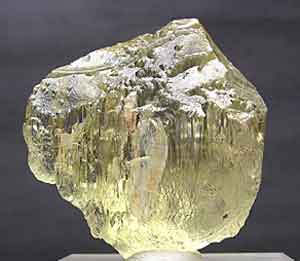
Speaking of elbaite, Scott Werschky of Miner’s Lunchbox (www.minerslunchbox.com) just got in some nice loose crystals of this species from a surprising new locality: Amarnath, Himachal Pradesh, India. The elbaite crystals are singly terminated, fat prisms to more than 14 cm long; they are translucent pale green, some with blue caps and/or blue highlights within. The terminations are compound and slightly domed, while the prism faces are heavily striated vertically and show a pleasant satiny luster. It seems that a few of these Indian elbaite crystals showed up in 2004 at Denver, and a few more showed up at Munich, but Scott then bought what was left of the contents of what he was told had been a single pocket—only about 10 crystals by the time of his deal.
Dr. James Truitt, when not busy running Acme Mining Company, which runs the Wiseman aquamarine mine at Spruce Pine, North Carolina, also manages a website called www.advancedmineral.com, which specializes in specimens from the elusive (some very old) localities of the southeastern United States. Most of these specimens are thumbnail-size, but where have you last seen good specimens in any size of things like fat, transparent amethyst crystals from Due West, South Carolina; lustrous scepter amethyst crystal groups from the recent workings at the Adams Farm, Hiddenite, North Carolina; or gleaming clusters of bladed epidote crystals from the old Clarence Wilson Farm, Bakersville, North Carolina? This site also offers minerals from general worldwide localities, but it’s the Dixie stuff that is intriguing and “different.”
Then there is Kevin Conroy of Kevin Conroy Minerals, St. Louis, Missouri (kcminerals.com), who has lots of eclectic surprises, also chiefly for the thumbnail collector, and mostly at very low prices. In three galleries of miscellaneous thumbnails, with generous text, all kinds of things jostle together—not all of the specimens are of top quality, but the mere looking is fun, for jostling here are (among others) szenicsite from Chile, malachite from the Onganja mine, conichalcite from Laurium, anorthoclase (a euhedral crystal) from Japan, galena from Příbram, and ferberite from Peru: all of these are one-of-a-kinders, and most were “reserved” when I checked. Special pages, besides, offer some very good old material from Bisbee, Morenci, and Tiger, Arizona; a hoard of small thumbnails of malachite-coated copper from the Wolf mine, Siegerland, Germany (this mine closed in 1962); cabinet specimens of lushly lustrous, iridescent blue-purple chalcopyrite crystals on matrix plates from the Brushy Creek mine, Missouri (a pocket strike in 2004); Ojuela mine adamite in a range of colors; fine small thumbnails of pyrargyrite from Fresnillo; and fluorite from the now closed Pea Ridge mine, Missouri.
Neither is the Web lacking in feasts for the eyes and potential depth charges for the bank accounts of high-end collectors. A dealership aptly named Exceptional Minerals (www.exceptionalminerals.com) has many pages of mostly cabinet-size specimens priced from the mid-hundreds to $30,000 (the highest specified price I saw), including many resales from famous collections such as those of Irv Brown, Steve Neely, Charles Leavitt, Ed David, and Gene Meieran. Of course, those who might just spring for a thumbnail anorthoclase would probably not also go for any of these Exceptional pieces, but just scrolling down them adds much zing to an otherwise slow afternoon. When I looked, the site featured large rhodochrosite specimens from the Sweet Home mine (inevitably, now, we will see fewer and fewer of these for sale, in any price range), and a whole gallery of magnificent specimens of native silver, these from localities antique (Freiberg, Kongsberg, Sarrabus, Aspen), through more recent (Batopilas, Upper Michigan), to an exceptional piece from a find at the Imiter mine, Morocco, which was made just before Tucson 2005.
On behalf of the Mineralogical Record I’d like to welcome Larry Conklin herewith to our Internet Directory—where soon for the first time you’ll see the listing for his website, www.lhconklin.com. To survey the site is to see, consistently, top specimens with top aesthetics, most of them classics from old collections. As has been true for years and still is, you can’t fully accredit yourself as a mineral connoisseur until you have spent some time—cybertime, in this case—with the man who always denoted himself in his print ads as “Lawrence H. Conklin, Mineralogist.”
Collection Sales
For most of his long lifetime (1892-1984), Señor Joaquín Folch I Girona of Barcelona accumulated what was surely one of the greatest “general” mineral collections (although very heavy in Spanish minerals) ever assembled anywhere. I still remember how Arthur Montgomery’s thorough description of the collection in the young Mineralogical Record (vol. 2, no. 1) in 1971 fired up my inexperienced mineralogical imagination, and I still regret that during my one visit to Barcelona, in 1982, I was unable to look in at the little museum where Sr. Folch displayed the collection. No new pieces have been added since the death of the great collector in 1984, but the good news is that the collection is still intact as he left it, still in its display facility (visits to which, however, are greatly restricted), and is the responsibility now of the grandson of Sr. Folch, who actually means to augment and update it, with help from a top-flight contemporary mineral dealer. And who else would that be but Jordi Fabre, also of Barcelona, on whose website (www.fabreminerals.com) you can read much more about the Folch collection and about how it is that today’s collectors will get, through Jordi, plenty of chances to buy Folch pieces over a generous span of time to come.
You will soon see Jordi’s ad about this in the Mineralogical Record: his commission is not to sell off any pieces from the “official” collection, but to sell duplicates from a “B” collection which was not publicly shown during Folch’s lifetime. No more than a quick scroll down the Folch pages already up on the website will show you that this “B” collection included some very fine things indeed: old Cornish specimens happen now to be featured, but almost anything might come up next. For quite awhile into the future, Jordi says, he will put Folch specimens of all types, sizes and prices onto these pages, as well as bringing selections of them to shows—his plan is not to start with the best stuff now and work down to the least but rather to grab specimens “at random” from the “B” stock to put onto the market. Watching it happen ought to be enlightening, and what’s more it ought to be cheering, since we will know that a great old collection is not, for a change, being dispersed, abused or neglected, but rather is being improved, partly with funds raised by these means.
Rob Lavinsky too is quite busy now marketing old collection material. Marilyn Dodge, based in Rhode Island, has spent more than 30 years assembling a collection of top-quality thumbnails. In order to devote more time and energy to micromounting, she is selling off the thumbnail collection, as well as some peripheral material: the suite of Colorado thumbnails and miniatures now on view at Rob’s site (www.irocks.com) ought to duly excite Colorado collectors while giving the rest of us, too, acquisitive little thoughts about why we need to tune in when the general thumbnail collection comes on line (soon) and appears at Denver.
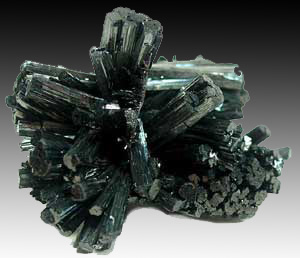
The same thought applies regarding the Violet Dawson collection of miniatures, which Rob is now beginning to market as well. With her husband, Norm Dawson, Violet owned and worked the White Queen mine, San Diego County, California, during its most active period of specimen production, and into the 1970’s she exhibited her miniatures widely at shows around southern California. Shown with the present report are pictures of three Dawson miniatures (Ilfeld, Germany manganite; Hiddenite, North Carolina emerald/quartz; an amazingly substantial andersonite from Utah), just to give you some idea. Rob says to remind everyone that he’s also going to be handling some rarities from the Marty Zinn collection, and many good things from the Ernie Schlichter collection, over the latter half of this year.
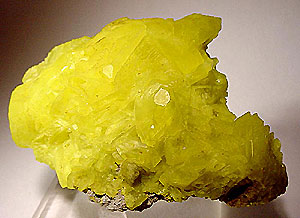 |
 |
Caveat Emptor Department
How do you say “buyer beware” in Romanian? [Late note: I’d meant this as a rhetorical question, but from the desk of Wendell Wilson there flashes an answer: “Achizitor atenţ ie.” Check your immediate perimeter before asking rhetorical questions…]. Anyway, Jaroslav Hyršl brings back from this year’s Ste.-Marie-aux-Mines show the news that he saw, among the show’s famously expansive spread of outdoor tents, booths and individual stands, “several tables” run by Romanian dealers where faked specimens “formed the majority” of the offerings, and one table filled “practically only” with fakes. He saw “matrix” stibnite specimens consisting of terminated Chinese stibnite crystals stuck into gray masses of finely ground-up, cemented stibnite; large gray octahedral crystals represented as scheelite, actually, potassium alum, glued onto plates of drusy quartz; “rhodochrosite” crystals which in fact are calcite stained pink by wet toilet paper. The newest rarity from Romania, judging by what was on hand at Ste.-Marie, seems to be “malachite” spheres made from mud mixed with green mica flakes and cemented onto quartz—the locality given for these was different at every stand where Jaroslav asked the question. Sorry to end this report on such a down note, but as-they-say Knowledge Is Power, as well as a Safeguarded Mineral Budget. 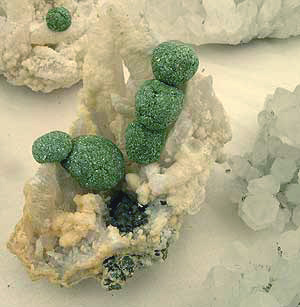
Postscript
I almost forgot the following fun announcement. Most Mineralogical Record subscribers have long been aware of our standing offer to send on request, free of charge, a special “illustrated specimen” label to the owner of any specimen which has been pictured in the magazine’s pages (extra-customized labels are available if the specimen in question appeared in one of the Special Issues). Well, you may now avail yourself of the same offer should you happen to come to own a specimen pictured in this website feature. Write or e-mail to the Editorial Office, and you shall receive a 2.5 x 3.5-inch stiff paper tag which says Illustrated Specimen – The Mineralogical Record Website Column – What’s New in the Mineral World. There are empty lines where you can fill in the specimen data, including the date of the picture’s posting.
And now let us hibernate until Denver…
For questions about this column, please email Tom Moore.
